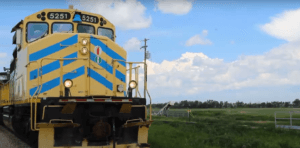When Tanner and I hopped in the car to head to Alberta, we didn’t know we were also heading back in time.
Our trip took us to Forestburg to check out The Battle River Railway co-operative, which is owned by farmers to move their grain to market. First, though, we got to check out the railway co-op’s very fun spin-off tourism business: Friends of the Battle River Railway. This organization uses the rails to take tourists on excursions to explore nearby towns, events and history.
As we drove from Saskatchewan to Alberta, passing fields of wheat and canola, we played a game I loved as a kid: basically, being the one to spot the most horses. As we neared our destination, I got more excited about the train trip that was in store.
(We lost track of who won the horses game – but it was probably me).
I had never been on a themed train ride, and I was looking forward to getting a new perspective on the countryside — especially from the open-air car I had heard about. The excursion we’d signed up for was the “Heisler Historic Run”, which promised a vintage hotel, some historic sights and “small town hospitality at its finest”.
As we approached the train, we were greeted by lovely BRR volunteers wearing full period attire. They welcomed us to the trip, served us drinks onboard and really set the atmosphere of the journey. We felt like we’d stepped back into the era where people relied on trains to cross the prairies.

The crew was kind enough to allow us to explore all areas of the train. The conductor even let us into the cab. I felt like I was on a school trip to the Western Development Museum. Unlike the museum trains, getting to see one that was fully functional was a unique experience.

As expected, the open-air car was a highlight for me. The only thing standing between you and the countryside is some chest high walls — allowing you to breathe in the fresh rural Alberta air.
And what a beautiful countryside it was. Having grown up in a small town I’m used to watching fields whiz by on the highway. At the slower pace of a train however, I found you take in a bit more. From early canola fields to watching a deer hop a fence there was a lot I would have missed otherwise.
Once the train pulled into the town of Heisler we were treated to a tour that lead to St. Martin Roman Catholic Church. Muriel, one of the tour guides, told us that before the church was built around 1920, worshipers held services in the local restaurant. She said that when the church was built, people had to rent their space in the pews for their families to attend services – and where you sat in the church became a status symbol.
She then joked about how churches almost have to pay people to attend today.
Muriel’s stories were a great illustration of small-town life in the past. She talked about the old convenience store, and the old ways of life — like how she used to deliver groceries to residents using a wagon during the warm months and a sled in the winter.
Whenever Muriel would mention someone’s name in one of her stories, she’d ask the group: “Is anyone a relative?” Every single time, someone raised their hand.
I always enjoy these opportunities to listen and discover more about a place.
Next up was a delicious perogy and sausage supper in the Heisler Hotel. The food was amazing — even though my travel partner Tanner doesn’t like sour cream on his perogies. (A heresy of the highest order in my opinion!)
All jokes aside, the food was straight out of someone’s grandma’s kitchen. After supper we had some spare time, so we went to visit Heisler’s baseball glove statue.

Small towns and their affinity for making big statues of small things is a great way to find what they’re proud of. For Heisler, their pride rests in their baseball teams. They’ve adopted “A Community of Champions” as their slogan and back this claim up by hanging billboards covered in baseball championships — all facing the highway for a passerby to see.
Then it was time for us to leave Heisler and we took another scenic ride back to where we’d started. We spotted some wildlife along the way — a few more horses.
After the trip we had the chance to speak with Ken Eshpeter, who played an important role in creating both the Battle River Railway as well as the “Friends.” Dressed in his conductor’s uniform, Ken told us about the most important part of the BRR’s formation: the purchasing of the railway.
Ken was both friendly and knowledgeable — two characteristics he makes great use of as a host for the excursions. Thank you, Ken for the great chats about prairie life, and thanks to everyone involved with the excursions for being so hospitable!

 Written by
Written by 


